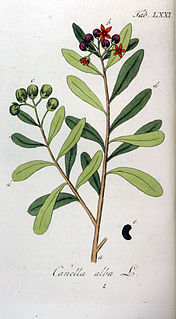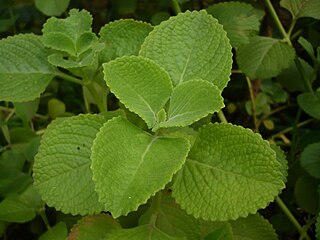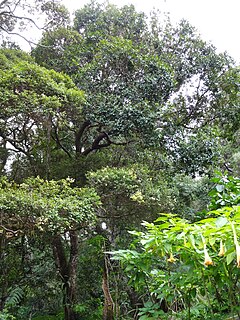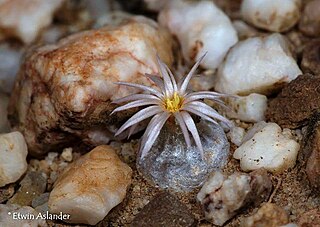
The International Plant Names Index (IPNI) describes itself as "a database of the names and associated basic bibliographical details of seed plants, ferns and lycophytes." Coverage of plant names is best at the rank of species and genus. It includes basic bibliographical details associated with the names. Its goals include eliminating the need for repeated reference to primary sources for basic bibliographic information about plant names.

Leucojum is a small genus of bulbous plants native to Eurasia belonging to the Amaryllis family, subfamily Amaryllidoideae. As currently circumscribed, the genus includes only two known species, most former species having been moved into the genus Acis. Both genera are known as snowflakes.

The Canellaceae are a family of flowering plants in the order Canellales. The order includes only one other family, the Winteraceae. Canellaceae is native to the Afrotropical and Neotropical realms. They are small to medium trees, rarely shrubs, evergreen and aromatic. The flowers and fruit are often red.

Coleus amboinicus, synonym Plectranthus amboinicus, is a semi-succulent perennial plant in the family Lamiaceae with a pungent oregano-like flavor and odor. The origin of Coleus amboinicus is unknown, but it may be native to Africa, and possibly India. Coleus amboinicus is widely cultivated and naturalized elsewhere in the tropics where it is used as a spice and ornamental plant. Common names in English include Indian borage, country borage, French thyme, Indian mint, Mexican mint, Cuban oregano, soup mint, Spanish thyme. The species epithet, amboinicus refers to Ambon Island, in Indonesia, where it was apparently encountered and described by João de Loureiro. Ambon is one of the Maluku Islands of Indonesia.

Johann Christian Daniel von Schreber, often styled J.C.D. von Schreber, was a German naturalist.
Index Fungorum is an international project to index all formal names in the fungus kingdom. As of 2015 the project is based at the Royal Botanic Gardens, Kew, one of three partners along with Landcare Research and the Institute of Microbiology, Chinese Academy of Sciences.

Brasenia is a genus belonging to the family Cabombaceae, consisting of one species, Brasenia schreberi. It is widely distributed in North America, the West Indies, northern South America, eastern Asia, Australia, the Indian Subcontinent, and parts of Africa.
Drosera monticola is a perennial carnivorous plant species in the genus Drosera, the sundews. This species is endemic to a single mountain range in Western Australia.

Sarracenia alabamensis, also known as the cane-brake pitcher plant, is a carnivorous plant in the genus Sarracenia. Like all the Sarracenia, it is native to the New World. S. alabamensis subsp. alabamensis is found only in central Alabama, while subsp. wherryi is found in southwestern Alabama, eastern Mississippi and Florida. It is sometimes treated as two subspecies of S. rubra.
Cereus elegans is a cactus species in the genus Cereus.

Markku Häkkinen was a Finnish self-taught botanist, considered one of the world's leading experts on the taxonomy of bananas. Forty-six out of the seventy known species of wild bananas have been described by Häkkinen. The Linnaean Society of London awarded him the H. H. Bloomer Award of 2009. In 2015 Häkkinen received the Finnish Cultural Foundation's Award for outstanding cultural achievement.

Vestia is a monotypic genus of flowering plants in the family Solanaceae containing the single species Vestia foetida. Its principal common names in the Mapudungun language of its native Chile are Huevil and Chuplín. Other Chilean names include Chuplí, Echuelcún and Palqui (negro), while an English common name Chilean box thorn has also been coined recently in reference to a certain similarity of the plant to some species in the box thorn / wolfberry genus Lycium. Vestia foetida is endemic to central and southern Chile, being found in an area stretching from the Valparaíso Region in the north to Chiloé Island in the south. Growing to 2 m (7 ft) tall by 1.5 m (5 ft) broad, it is an evergreen shrub with glossy, privet-like, mid-green leaves. In spring and summer it bears tubular yellow flowers to 3 cm (1 in) long, with stamens so markedly exserted as to recall those of certain Fuchsia species, followed by 4-valved, ovoid capsules to 1 cm (0 in), containing small, prismatic seeds.
Louis Auguste Joseph Desrousseaux was a French botanist and pteridologist. He was a contributor to the "Encyclopedia Botanique" of Lamarck, from 1783 to 1796.

Scolopia crassipes is a species of plant in the family Salicaceae. It is endemic to Sri Lanka.
Acanthochlamys is a genus of herbaceous plants described as a genus in 1980. It has long been included in the Amaryllidaceae, but more recent systems place it in the Velloziaceae. Kao in 1989 placed in its own family, the Acanthochlamydaceae.

Iris subbiflora is a plant species in the genus Iris, it is also in the subgenus Iris. It is a rhizomatous perennial, from Portugal and Spain in Europe. It has evergreen broad leaves, forming dense clumps, it has dwarf stems in late spring,, with 1 upright fragrant flower, in shades of purple, light red purple, grey-blue, blue-violet, or dark violet. It has a beard which is generally blue, purple, or violet, but can fade to white, dull yellow, or dark yellow. After being found in 1804, it was once a separate species until the late 70s, when it was reclassified as subspecies of Iris lutescens, and renamed Iris lutescens subsp. subbiflora. But in the 80s it was returned to an independent species but some authors and references still class the species as a synonym or subspecies. It is cultivated as an ornamental plant in temperate regions.

Conophytum hammeri is a small, endangered, South African species of succulent plant, of the genus Conophytum.

Pandanus rigidifolius is a species of plant in the family Pandanaceae, endemic to Mauritius.
Robert J. "Rob" Bates is an Australian botanist, plant collector, and illustrator.

Symphyotrichum patens, commonly known as late purple aster or spreading aster, is a perennial wildflower found in the eastern United States.













